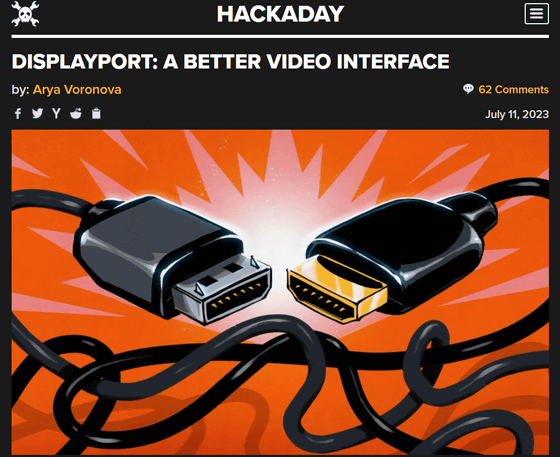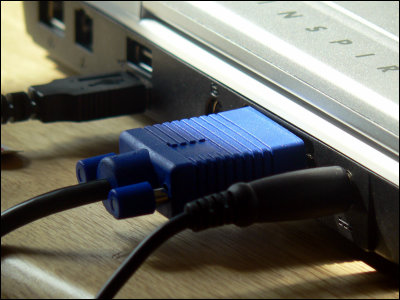What is amazing about the video interface standard 'DisplayPort'?

DisplayPort , an interface standard for digital display devices such as video displays, is now installed in many PC monitors and graphic boards, and has become one of the major video standards. Hackaday, a technical news site, explains such DisplayPort.
DisplayPort: A Better Video Interface | Hackaday

DisplayPort was designed by VESA , an industry standardization organization for video peripherals, to succeed VGA , an analog RGB terminal, and DVI , a serial interface capable of transferring digital data. Hackaday says, ``DisplayPort has all the features of interfaces such as HDMI, but eliminates the traditional extras and is implemented using a more robust architecture.''
HDMI, a digital video interface standard mainly used for home TVs, recorders, and game consoles, adopts a serial transmission method called TMDS . The reference clock is disassembled into one channel and transferred. It may be said that the HDMI video transmission method is similar to VGA and DVI in that the video is divided into three RGB channels.
However, DisplayPort uses the micropacket method, and transfers stream data in micropackets of units called 'Transfer Units'. In other words, unlike HDMI and VGA, the main feature of DisplayPort is that the data is sent as it is, while the data is finely packed into micropackets, instead of being broken down into video signals. Therefore, DisplayPort has become a highly flexible standard as an interface to the extent that it can also support other standards.

The data transmission format that has coexisted with this DisplayPort is Thunderbolt . Thunderbolt uses DisplayPort for video and audio signals, and Thunderbolt1 and Thunderbolt 2 use Mini DisplayPort for connectors. Also, from Thunderbolt 3, a USB Type-C connector was adopted, but it is possible to output video with DisplayPort.

by MomentMedia TechFever Network
In addition, DisplayPort transfers data in micro-packets, making it possible to transfer multiple video stream data within a single link. This is a feature called Multi-Stream Transport (MST), which essentially allows you to use multiple monitors with a single DisplayPort output. To display multiple monitors at the same time, you can either use a device called an 'MST hub', or if the monitor is equipped with an MST compatible chip and has a DisplayPort output terminal, you can connect the monitors with a DisplayPort cable. You need to make a 'daisy chain' connection.
The DisplayPort terminals are 20 pins in total, of which the main lane is 4 types x 2 pins. However, depending on the amount of data transfer, it may not be necessary to use four main lanes, in which case the bandwidth will be lower, but less wiring will be required. This feature is used in the eDP (embedded DisplayPort) standard. Video interfaces for notebook PCs and smartphones require high resolution, low power consumption, and low cost. Wiring of 6 x 2 pins or 8 x 2 pins is required, but with eDP it can be realized with 2 lanes x 2 pins, so design can be done at a lower cost.
In addition, Hackaday says, 'The nice thing about DisplayPort is that it's not HDMI.' Neither HDMI nor DisplayPort is a standard that can be used openly, but HDMI has considerably stronger restrictions. In fact, AMD has not been able to implement support for high resolutions and FreeSync in its drivers for Linux, but it has long been pointed out that the reason for this is that the HDMI standard is quite restricted.
Pointed out that the closed structure of the HDMI industry adversely affects open source GPU drivers - GIGAZINE

Hackaday says, 'DisplayPort is a much friendlier interface than you might expect. Intel and AMD have been betting big on DisplayPort since it came out. Now, even if you can't see the DisplayPort connector from the outside, you can still use it for portable devices. It has become a staple interface. HDMI is like a second-class citizen. DisplayPort has enough advantages to be treated as first-class.'
Related Posts:
in Hardware, Posted by log1i_yk






